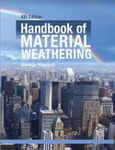The 6th edition of Handbook of Material Weathering contains a systematic update of knowledge generated in more than last 25 years since the 1st edition was published. For example, in the last 5 years, more than 8,000 new papers (30 new papers per week) have been published on the material weathering, some of them having high importance for the weathering studies.
The information required for the professional use has been growing so rapidly that additional books had to be written to accommodate essential knowledge for implementation in technological processes used to manufacture products, which deteriorate on exposure to weathering stress factors (see more information on these titles in Preface).
This edition contains 22 chapters, which can be divided into the following groups:
- Theory (photophysics and photochemistry)
- Stress factors (parameters of exposure, measurements in assessment of weathering conditions, and climatic conditions)
- Methods of weathering (laboratory degradation studies, weathering cycles, sample preparation, weathering data interpretation, lifetime prediction, and artificial weathering versus natural exposure)
- Methods of testing of weathered samples (effect of weathering on material properties and testing methods of weathered specimens)
- Weathering of polymers (data on 52 most important polymers, including mechanisms of degradation, effect of thermal history, characteristic changes in properties with graphical illustrations, and tables with numerical data)
- Weathering of products (data on 42 groups of industrial products, including their required durability, lifetime expectation, relevant degradation mechanisms, and characteristic changes with graphical illustrations)
- Effect of additives on weathering (12 groups of additives are discussed)
- The most popular UV stabilizers, biocides, and preservatives used in protection of polymers, plastics and rubbers and the general principles of degradation, biodeterioration, and stabilization
- Effect of environmental stress cracking (parameters controlling ESC, mechanisms, methods of testing, and effect on materials)
- Specific topics (suitability of weathered materials for recycling, interrelation between corrosion and weathering, and methods of study and prevention of deterioration of historical monuments made out of stone)
The above information is based on the thorough review of published papers, patents, and other relevant sources updated by the most recent data and information.
The set of monographic sources (see more information in Preface below) was prepared for research chemists in the photochemistry field, chemists and material scientists designing new materials, users of manufactured products, those who control the quality of manufactured products, and students who want to apply their knowledge to real materials. The books are used by regulating agencies and patent and litigating attorneys.
Handbook of Material Weathering is now used in more than 100 countries. It should be pointed out that many readers still use the earlier editions (as seen from the numerous citations) which lack the current information or even, more detrimental, contain outdated information which has been superseded by the more recent findings. In this fast-growing field, the access to the most recent information cannot be overemphasized. For this very reason, a new edition of this book is prepared every five years.
Author
George Wypych has a Ph. D. in chemical engineering. His professional expertise includes both university teaching (full professor) and research & development. He has published 17 books: PVC Plastisols, (University Press); Polyvinylchloride Degradation, (Elsevier); Polyvinylchloride Stabilization, (Elsevier); Polymer Modified Textile Materials, (Wiley & Sons); Handbook of Material Weathering, 1st, 2nd, 3rd, and 4th Editions, (ChemTec Publishing); Handbook of Fillers, 1st, 2nd and 3rd Editions, (ChemTec Publishing); Recycling of PVC, (ChemTec Publishing); Weathering of Plastics. Testing to Mirror Real Life Performance, (Plastics Design Library), Handbook of Solvents, Handbook of Plasticizers, Handbook of Antistatics, Handbook of Antiblocking, Release, and Slip Additives (1st and 2nd Editions), PVC Degradation & Stabilization, PVC Formulary, Handbook of UV Degradation and Stabilization, Handbook of Biodeterioration, Biodegradation and Biostabilization, and Handbook of Polymers (all by ChemTec Publishing), 47 scientific papers, and he has obtained 16 patents. He specializes in polymer additives, polymer processing and formulation, material durability, and the development of sealants and coatings. He is included in the Dictionary of International Biography, Who's Who in Plastics and Polymers, Who's Who in Engineering, and was selected International Man of the Year 1996-1997 in recognition for his services to education.








